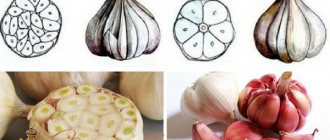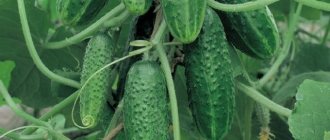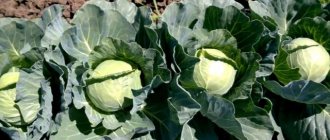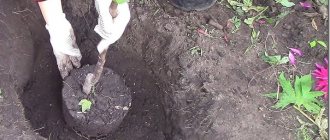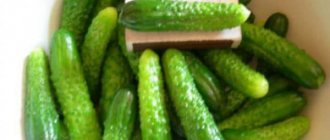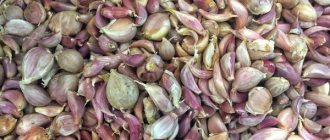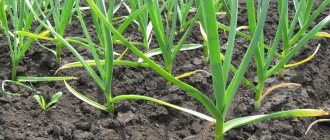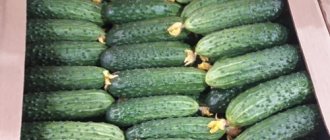Vegetable growing » Garlic
0
1790
Article rating
Kira Stoletova
Heirloom garlic allows you to grow a much larger crop than from seeds or garlic cloves of classic varieties. It grows in whole bushes and is highly productive.
Growing heirloom garlic
Description of Family Garlic
Before you start planting and growing this variety, you need to familiarize yourself with its description and distinctive characteristics in more detail.
This variety is no different from other bush varieties of vegetables. Family garlic got its name due to the fact that not just one bulb or clove is formed on its head, but about 5-6 pieces at once. Their size is much smaller than regular varieties of the vegetable, but they weigh about the same.
The distinctive features of the fruits include their bright taste and aromatic smell, which can be noticed immediately after digging up the garlic. Also, the advantages of the harvested crop include the storage duration, which is more than 10 months. Under optimal conditions, garlic fruits can be stored for one and a half years.
The harvested crop is often used in the culinary field in the preparation of vegetable dishes or preserves. Garlic heads are also sometimes used in medicine to create medicinal decoctions and infusions.
Some vegetable growers are confident that only residents of the middle zone of the country will be able to get a good harvest, since that is where the best conditions for growing vegetables are. In other parts of the country, yields will be slightly lower if garlic bushes are not grown in greenhouses or greenhouses. Experienced gardeners advise growing the variety in greenhouse conditions to protect the bushes from pests and temperature changes.
Planting garlic before winter
Once the seeds and area are ready for sowing, it’s time to begin the main stage. To comply with the technology, it is important to adhere to the sequence of work. It is as follows:
- Planting technology begins with the formation of furrows. Depth: 15-20 cm, pitch: 20-25 cm.
- Drainage (can be regular sand) about 3 cm high is poured at the bottom of the furrow. This is necessary to drain excess moisture and preserve the roots.
- The depth of the holes should not be very large. The teeth are planted at a distance of 15 cm, if the material is small - 7 cm.
Next comes the sealing. After everything is planted, the bed should be protected from the cold using film or roofing felt. The process is like this:
- The cloves are planted to a depth of 3 cm, the step is 2 cm in a row, 10 cm between rows. There is no need to push the cloves too hard, otherwise the roots will not form well. They take root well if the soil under them is moderately soft.
- After planting, the soil does not need to be watered, just mulch the soil with peat chips. Height – up to 3 cm. This is necessary for protection from the cold if the soil freezes.
Types and varieties
There are two main varieties of garlic that you need to familiarize yourself with in advance - winter and spring.
Winter
This type of garlic is not planted in spring, but in mid-autumn. Most often, planting begins on October 1-5. However, in warm weather, you can postpone the procedure to the 15th-20th. Each vegetable grower determines the optimal planting time independently, depending on the weather and outside temperature.
Winter garlic is distinguished by the size of its fruits, consisting of several identical cloves. If you cut the onion into two equal parts, you will notice that in the center there is an arrow around which all the garlic cloves are located.
At the moment of flowering, small empty flowers without seeds form on the bushes. The seeds are found in aerial bulbs that appear on the plant after flowering.
Spring
The distinctive features of this species include the fact that its bulbs do not have a central stem. Also, adult plants do not form bulbs in the upper part of the bushes, and therefore spring garlic reproduces only with the help of young cloves.
The fruit size of this species is much smaller than that of the winter variety. However, one onion contains about 10-15 cloves. They are all completely different and differ in size. The harvested spring garlic crop is perfectly stored even in rooms at room temperature. Under optimal conditions, it will not deteriorate within 1-2 years.
general characteristics
Probably everyone has heard or grown family onions, where you can get up to 5 full-fledged onions from one head. Heirloom garlic grows the same way. It is convenient to plant it in small areas, where gardeners harvest a good harvest of vegetables from a fairly small area.
Botanical description
- The culture is not particularly different from other garlic varieties. The main distinguishing feature is that one clove produces 5 to 25 young heads, which increases the yield significantly. When the quantity is large, the head diameter is smaller.
- The big advantage is the wonderful rich aroma and excellent taste. The culture has one more advantage: a high degree of keeping quality. The fruits can be stored for about 11 months. If you follow the storage rules, you can preserve vegetables for more than one and a half years.
- The size of the vegetable is smaller than that of other varieties of garlic. However, they weigh approximately the same. Judging by the reviews, the “Family” variety is best grown in a temperate climate. Therefore, it is very popular among gardeners in central Russia.
- In more northern regions, the crop should be grown under cover, in closed ground, in greenhouses and greenhouses of various types. If grown in open soil, the head size will be small.
- Experienced gardeners recommend growing them in a greenhouse, this way you can protect the crop from harmful insects and sudden temperature changes.
Main varieties
There are several of them. Let's look at each in more detail.
Winter
This species is planted in the second half of October, shortly before the first frost. And that’s why the name is “before winter.” You need to focus on weather conditions. You can’t plant it too early to prevent the plant from germinating. But there is no need to delay it too much. It is important to choose a time before the soil freezes, but the heat will definitely not return.
- The main difference between this garlic is the larger size of the fruit, which consists of several cloves of equal size.
- If you carefully cut the head, you will notice an arrow located in the middle. All the teeth are located around it.
- During the flowering period, small flowers bloom on peduncles, and then seed pods form. They are presented in the form of air bulbs.
Gardeners do not recommend this method of growing garlic, since in most cases there is a large percentage of bolting of the crop. It is better to plant in the spring.
Spring
This variety can only be propagated using young cloves. There is no central stem here. There is also no formation of bulblets at the tops of the above-ground part.
- The heads in circumference are slightly smaller than those of winter. But the number of cloves is larger - at least 10 - 15.
- The sizes of the teeth can vary: there are both larger ones and very small ones.
- The great advantage is the storage of this species: at normal room temperature, the culture retains its elasticity and juiciness for at least several years. It is important that there is no high level of humidity.
Preparing seedlings
Before you start planting garlic in open ground, you should start growing seedlings. It is recommended to plant it in autumn or winter so that by spring the seedlings can be transplanted into the garden.
See also
Description of the Kharkov purple garlic variety, features of cultivation and careRead
Soil preparation
Garlic loves soil that contains many nutritional components and therefore it is better to prepare the soil mixture in advance. To do this, the earth is mixed in equal quantities with wood ash, nitrophoska and superphosphate.
After adding fertilizers to the soil, the soil is disinfected to remove pests and pathogens from it. To carry out this procedure, copper sulfate is added to the ground.
Some vegetable growers add peat with loam and sand to the soil to improve the quality of the soil mixture.
Selection of capacity
Before growing garlic seedlings, you need to decide in what container it will grow. Some advise growing it in plastic pots, in which almost all plants take root.
However, these pots are quite small, so it is better to use boxes instead. You can grow several seedlings in them at once. Instead of planting boxes, you can use cassette containers, which consist of several combined pots.
Landing
Having chosen a container for planting and prepared the soil mixture, you can begin planting.
First, all containers are filled to the top with soil and watered with warm water. Then shallow holes are made for planting the garlic cloves. When all the garlic has been placed in the soil, it is covered with soil and watered again. All containers with planted garlic are transferred to a warm room for further cultivation.
Conditions for planting teeth
Planting depth
It is influenced by planting time, region and soil structure. Deep planting (10-15 cm) is practiced during early planting. The planting material will have time to take root well and will successfully survive low temperatures. Traditionally, garlic cloves are planted to a depth of at least 5 cm, and bulbs - at least 3 cm.
Distance
Between the cloves there should be a space of 10-15 cm. Plants should not be planted thicker, as the heads will form small and it will be difficult to care for them.
Planting scheme
It is better to plant garlic on low (up to 25 cm) ridges. The distance between the rows according to the pattern is from 20 to 30 cm. For ease of maintenance, no more than 4-5 rows are placed on one ridge.
In the video, the agronomist explains and shows what depth to plant garlic and whether it needs to be covered with sand.
When can you plant?
When using the seedling method of growing garlic in open ground, it is planted in the spring. Many people believe that spring planting is much easier than autumn planting. In this case, you do not have to spend a lot of time and effort preparing the site.
Before you start planting seedlings, you need to pay attention to the temperature outside. Planting is worth doing only if it does not fall below zero degrees. Even slight frosts can destroy planted garlic. Therefore, it is recommended to plant no earlier than the second half of April.
Also, before planting, pay attention to garlic seedlings. It must be strong enough, since weak seedlings will not be able to take root normally in the garden. Seedlings cannot be transplanted into open ground if their height is less than 5-6 cm. Such weak seedlings can only be planted in greenhouses, where optimal temperature and air humidity are maintained.
Care after landing
If you plant garlic in the fall, then in the spring it will not cause much trouble. The vegetable itself tolerates cold well. The rooted plant will survive the winter period very resistant to the onset of cold weather. In the spring, in order for the seedlings to germinate faster, the cover and part of the mulch are removed. At the end of June the plant shoots arrows. They break out at a height of 10 cm. If this is not done, the bulb will be small. When the first greenery appears, the soil is fertilized: urea, a solution of bird droppings or mullein are added.
After a month, the following feeding is done: a bucket of water and 200g of ash. Watering is moderate: a liter of solution for several rows. When active growth occurs, the plant is watered a lot, but in rainy weather this should not be done - the roots may become sick and rot. After watering, the bed is loosened, and soil is sprinkled if necessary. As soon as the seedlings begin to grow, they are watered less frequently.
Soil preparation
Family garlic, like all other varieties, grows well in sandy loam and light soil. Therefore, if the site has loamy soil, then expanded clay mixed with sand will have to be added to it. These components improve the drainage properties of the soil several times, so that it absorbs moisture better.
Also, this vegetable grows much better in fertile soil with nutritional components. To increase fertility, the area is treated with manure. It is not recommended to fertilize the soil with fresh organic fertilizers along with it, as this will negatively affect the yield of garlic.
The soil is prepared only after it has completely warmed up at the end of March. The entire area is carefully dug up so that the earth is not too dense. Then, about 4-5 kg of humus is consumed for each square meter of garden.
To increase productivity, you can add a few tablespoons of urea and superphosphate to the soil.
Areas with aluminous soil are fertilized with humus from fallen leaves, peat and river sand. After adding fertilizers, the soil throughout the entire area will have to be loosened again and watered with warm water to increase humidity.
See also
Correct timing when it is better to remove winter garlic from the garden for storageRead
How to choose a landing site
How to plant garlic correctly before winter, what place to choose for the beds? The vegetable is a very capricious crop. Therefore, planting winter garlic should be done in the right place. He loves light, fertile, moisture- and water-permeable soil, sandy loam soil. Soils that are acidic will not be suitable. The area of the house or country house where garlic will be grown must meet the following requirements:
- the soil is well fertilized;
- an elevated place, without stagnant water;
- good lighting.
Some gardeners make raised beds if the soil is very wet, but this is not very beneficial for garlic. Preference is given to areas:
- where there is a lot of snow;
- no access for animals;
- where the ice crust forms.
The best option is a plot near the fence, but on the north side. During winters with little snow, the fence will retain the snow and prevent the plant from freezing. The shadow from the fence will preserve the ice crust.
Illumination of the area
Before planting the “stone onion”, you need to choose a well-lit place. The vegetable is a light-loving crop, so it is necessary to plant the bed in sunny places. It would be wrong to plant a plant near trees or buildings. The bed is located in a bright place, protected from the north wind. A well-lit area will help the garlic take root and produce a high yield.
No moisture accumulation
Moisture is the enemy of garlic. The need to choose a non-humid or elevated place is dictated by the fact that this crop is a very demanding plant with a delicate root system. If the ground is very wet, the roots of the plant will begin to rot, become sick, and pests will appear. In addition, very wet soil can provoke the growth of the ground mass, rather than the crop bulb.
Formation of ice crust on the ground
An ice crust appears on the soil at certain times of the year. If you find the right place in your garden, you can safely plant a crop there. A crust of ice will keep the earth at a constant temperature during the winter cold. If there is no such area, you can save the “stone bow” from freezing with covering material. Such materials protect the crop from frost and prevent possible waterlogging of the soil.
snowy place
Snow is very important for many winter crops. It is especially needed for garlic. Without enough snow, the plant will simply freeze - all autumn work will be destroyed. Therefore, when choosing a location, you should give preference to areas near fences. They will retain the snow mass. If there is no suitable area, it is recommended to install a special fence.
Landing
Before planting, it is recommended to determine the area of the garden that is best suited for growing garlic bushes. To do this, you need to figure out, after which you need to plant garlic. Garlic seedlings grow well in areas where peas, beans or pumpkins were grown. It is not recommended to plant them in places where cucumbers, carrots or onions previously grew.
Having chosen a suitable plot in the garden and finished preparing the soil, they begin planting. First you should start marking the beds on which the bushes will grow. The distance between the beds is made at least 35 cm. After marking, small holes are made on each bed with a depth of no more than 10 cm. The holes should be 25-30 cm apart from each other.
Garlic seedlings must be planted very carefully so as not to damage anything. Before placing the seedlings in the ground, all holes are thoroughly moistened with water. Then the seedlings are planted in an upright position in the furrows, sprinkled with soil and watered again. Some gardeners mulch the soil after planting to protect the seedlings from possible temperature changes.
Landing Features
For heirloom garlic, you can choose one of two available planting methods:
- before winter (winter), which is planted in the fall,
- or for the summer (spring). It is planted when spring warmth arrives.
It is believed that summer, spring crops produce more harvests. When planted for winter, bolting is often observed, which reduces yields.
Planting directly depends on the temperature conditions of both the soil and the air. You should not plant garlic crops before the temperature reaches 5°. This period usually falls in the last days of April, and during a long winter it can be in the first days of May.
In any of the two possible methods, the family variety is planted in cloves.
Scheme
When planting, the seeds are deepened by 5 cm
The planting scheme for spring vegetables assumes the presence of inter-row distances of 0.2-.0.5 m and between cloves of 15-20 cm. Garlic bulbs are planted to a depth of 5cm, bottom down. When planting winter crops, the cloves are deepened by 10-15 cm.
Care requirements
Garlic, like any other vegetable, must be constantly looked after during cultivation. Proper care of garlic bushes will speed up their growth and improve productivity.
Watering
Without enough moisture, the shoots of the plant begin to turn whitish and gradually wither. Therefore, it is necessary to periodically moisten the soil so that the bushes do not dry out. The bushes are watered every 3-4 days so that the soil does not have time to dry out and is always moist. If there are often cloudy days outside, the number of waterings is reduced to once a week. It is recommended to water the seedlings in the evening, after sunset.
Fertilizer
When growing, garlic is fertilized in three stages. For the first time, fertilizing is applied to the soil after the first true leaves appear. In this case, a solution prepared from water and urea is added to the soil.
The second feeding is carried out two and a half weeks later, before flowering. The site is fertilized with nitroammophoska and nitrophoska. The final stage of feeding garlic is carried out at the beginning of summer, when the bulbs are formed. The soil is fertilized with a solution of superphosphate.
Weeding and loosening
After watering, it is necessary to loosen the soil, since the surface of the earth is covered with a dense crust. If you do not get rid of it in a timely manner, the supply of oxygen and moisture to the roots will deteriorate.
For the first time, the soil is loosened 15 days after planting the seedlings. Repeated weeding is carried out after a week and a half. When loosening the soil, be sure to weed out all the weeds, which could deteriorate the fertility of the soil.
Preparing a bed for winter garlic
Mandatory pre-sowing activities include preparing the bed for garlic:
- preparatory procedures begin at the end of August;
- the site for laying out the beds is chosen on the illuminated side, the location of the beds is north-south;
- the area is dug up to 15-20 cm;
- the distance of the bed is no more than 70-80 cm, on both sides of the bed there are 2 rows;
- distance between bulbs – 10 cm;
- When digging, humus, compost, ash, and complex mineral fertilizers are added (2 tablespoons per 1 sq. m), depending on the composition and fertility of the soil.
Advice for summer residents. When planting garlic bulbs in the fall, cat litter based on Zeolites (volcanic minerals) is added to the holes. The zeolite granules in the composition contain a lot of silicon (an important mineral for garlic). In addition, the granules, gradually dissolving, loosen the soil and have a positive effect on the air permeability of the soil.
How to prepare a garden bed for winter garlic
The optimal method of planting garlic is ridge:
- draw longitudinal rows on the ridge with a flat cutter;
- distance between rows – 30-35 cm;
- place the cloves horizontally on their sides;
- Press the planting segments 1-2 cm deep;
- leave the planting open for 30-40 minutes in the sun;
- Use a rake or hoe to form a ridge 7-8 cm high on top;
- the earth on the ridge is lightly compacted;
- no need to water or fertilize;
- protect garlic plantings in cold regions from drying winds;
- You can place cut raspberry branches on top of the covering material to create a warm cushion.
Attention! It is impossible to deeply bury the seed material into the soil; 4-5 cm is enough.
The seeds take a long time to emerge from the depths, form an irregular head, the development of the root system and above-ground parts is slow and sluggish.
Many gardeners, after sowing garlic on top, sow green manure from the Cruciferous family:
- Mustard is an annual herb that is superior in nutritional composition to humus and manure. Thanks to glycosides and mustard oil, it perfectly disinfects the soil and suppresses the growth and reproduction of weeds. It nourishes even depleted soil with minerals, fatty oils, phospholipids, and proteins.
- Oilseed radish is a herbaceous annual that loosens and structures the soil. Retains snow, resists freezing of the top layer of soil, water and wind erosion. The culture protects against the development of pathogenic flora (viral, bacterial and fungal infections).
Attention! Green manure is a natural source of nutrition and energy, providing soil aeration (looseness and water permeability of the fertile layer). Garlic absolutely does not tolerate stagnant moisture in the beds.
Spring garlic care
We must not forget that garlic requires care and attention after winter. The soil is washed away by autumn rains and spring floods.
First of all,
they replenish the loss of nutrients:
- scatter urea over the ridges (1 tbsp without a slide per 1 sq. m), directly over the crust of snow and ice, in early spring;
- later, when the snow melts, water the beds of young shoots of garlic with a light nitrogenous solution of ammonia - 2 tbsp. l. per garden bucket, 8-10 liters of water;
- the first feeding with ammonia - during the development of 3 leaves (feathers) of garlic;
- the second feeding with phosphorus and potassium - when the plant enters the fruiting phase, real 6-9 leaves-feathers grow; Potassium sulfate, potassium magnesium, and potassium magnesium are used.
Secondly, the beds need “health-improving” care:
- all clods and potholes in the ridge are broken after watering, the soil is slightly loosened to retain moisture in the fertile layer and root space;
- abundant watering is required 2 times a week;
- watering is alternated with nitrogen fertilizing; You can water along the ridges or between the rows;
- Phosphorus and potassium fertilizers are applied in well-watered beds.
Complete instructions for planting winter garlic in one video:
Harvest and storage
The ripe garlic crop is harvested from the second half of summer until the beginning of September. Before harvesting the fruits, you need to make sure that the old feathers on the bushes have turned yellow and new ones have stopped appearing. If you do not collect the garlic in time, its growth will reactivate and the heads will gradually begin to disintegrate into small pieces.
The entire harvested crop is dried for several days in a ventilated area and transferred to the cellar for further storage.
Harvesting
Harvesting is done on a dry, sunny day. Garlic is pulled out of the ground, left to dry in the beds until evening, then collected and placed in the attic or under a shed. After the garlic dries, you need to remove the stem and leaves. Garlic is stored braided. You can use special boxes where the garlic is placed, sprinkled with salt. The shelf life of garlic is 6-8 months.
The bed needs to be dug up right away; garlic cannot be planted in this bed next year, and onions too. You can prepare this bed for planting legumes.
